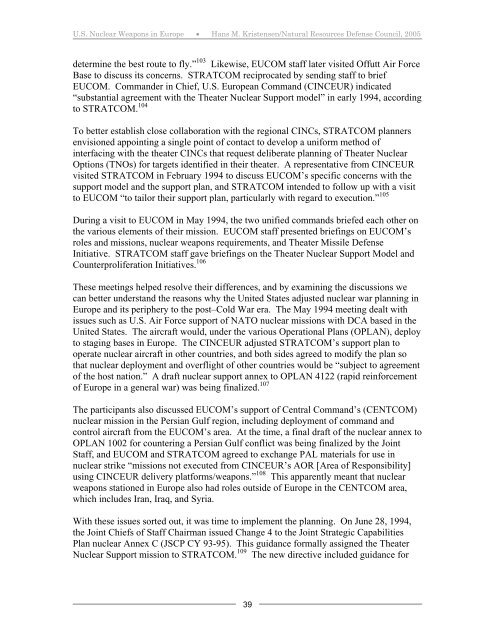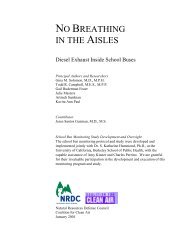US Nuclear Weapons in Europe - Natural Resources Defense Council
US Nuclear Weapons in Europe - Natural Resources Defense Council
US Nuclear Weapons in Europe - Natural Resources Defense Council
Create successful ePaper yourself
Turn your PDF publications into a flip-book with our unique Google optimized e-Paper software.
U.S. <strong>Nuclear</strong> <strong>Weapons</strong> <strong>in</strong> <strong>Europe</strong> • Hans M. Kristensen/<strong>Natural</strong> <strong>Resources</strong> <strong>Defense</strong> <strong>Council</strong>, 2005<br />
determ<strong>in</strong>e the best route to fly.” 103 Likewise, EUCOM staff later visited Offutt Air Force<br />
Base to discuss its concerns. STRATCOM reciprocated by send<strong>in</strong>g staff to brief<br />
EUCOM. Commander <strong>in</strong> Chief, U.S. <strong>Europe</strong>an Command (CINCEUR) <strong>in</strong>dicated<br />
“substantial agreement with the Theater <strong>Nuclear</strong> Support model” <strong>in</strong> early 1994, accord<strong>in</strong>g<br />
to STRATCOM. 104<br />
To better establish close collaboration with the regional CINCs, STRATCOM planners<br />
envisioned appo<strong>in</strong>t<strong>in</strong>g a s<strong>in</strong>gle po<strong>in</strong>t of contact to develop a uniform method of<br />
<strong>in</strong>terfac<strong>in</strong>g with the theater CINCs that request deliberate plann<strong>in</strong>g of Theater <strong>Nuclear</strong><br />
Options (TNOs) for targets identified <strong>in</strong> their theater. A representative from CINCEUR<br />
visited STRATCOM <strong>in</strong> February 1994 to discuss EUCOM’s specific concerns with the<br />
support model and the support plan, and STRATCOM <strong>in</strong>tended to follow up with a visit<br />
to EUCOM “to tailor their support plan, particularly with regard to execution.” 105<br />
Dur<strong>in</strong>g a visit to EUCOM <strong>in</strong> May 1994, the two unified commands briefed each other on<br />
the various elements of their mission. EUCOM staff presented brief<strong>in</strong>gs on EUCOM’s<br />
roles and missions, nuclear weapons requirements, and Theater Missile <strong>Defense</strong><br />
Initiative. STRATCOM staff gave brief<strong>in</strong>gs on the Theater <strong>Nuclear</strong> Support Model and<br />
Counterproliferation Initiatives. 106<br />
These meet<strong>in</strong>gs helped resolve their differences, and by exam<strong>in</strong><strong>in</strong>g the discussions we<br />
can better understand the reasons why the United States adjusted nuclear war plann<strong>in</strong>g <strong>in</strong><br />
<strong>Europe</strong> and its periphery to the post–Cold War era. The May 1994 meet<strong>in</strong>g dealt with<br />
issues such as U.S. Air Force support of NATO nuclear missions with DCA based <strong>in</strong> the<br />
United States. The aircraft would, under the various Operational Plans (OPLAN), deploy<br />
to stag<strong>in</strong>g bases <strong>in</strong> <strong>Europe</strong>. The CINCEUR adjusted STRATCOM’s support plan to<br />
operate nuclear aircraft <strong>in</strong> other countries, and both sides agreed to modify the plan so<br />
that nuclear deployment and overflight of other countries would be “subject to agreement<br />
of the host nation.” A draft nuclear support annex to OPLAN 4122 (rapid re<strong>in</strong>forcement<br />
of <strong>Europe</strong> <strong>in</strong> a general war) was be<strong>in</strong>g f<strong>in</strong>alized. 107<br />
The participants also discussed EUCOM’s support of Central Command’s (CENTCOM)<br />
nuclear mission <strong>in</strong> the Persian Gulf region, <strong>in</strong>clud<strong>in</strong>g deployment of command and<br />
control aircraft from the EUCOM’s area. At the time, a f<strong>in</strong>al draft of the nuclear annex to<br />
OPLAN 1002 for counter<strong>in</strong>g a Persian Gulf conflict was be<strong>in</strong>g f<strong>in</strong>alized by the Jo<strong>in</strong>t<br />
Staff, and EUCOM and STRATCOM agreed to exchange PAL materials for use <strong>in</strong><br />
nuclear strike “missions not executed from CINCEUR’s AOR [Area of Responsibility]<br />
us<strong>in</strong>g CINCEUR delivery platforms/weapons.” 108 This apparently meant that nuclear<br />
weapons stationed <strong>in</strong> <strong>Europe</strong> also had roles outside of <strong>Europe</strong> <strong>in</strong> the CENTCOM area,<br />
which <strong>in</strong>cludes Iran, Iraq, and Syria.<br />
With these issues sorted out, it was time to implement the plann<strong>in</strong>g. On June 28, 1994,<br />
the Jo<strong>in</strong>t Chiefs of Staff Chairman issued Change 4 to the Jo<strong>in</strong>t Strategic Capabilities<br />
Plan nuclear Annex C (JSCP CY 93-95). This guidance formally assigned the Theater<br />
<strong>Nuclear</strong> Support mission to STRATCOM. 109 The new directive <strong>in</strong>cluded guidance for<br />
39
















